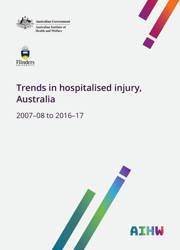Summary
This report describes trends in the occurrence of injuries requiring hospitalisation in Australia, for the 10-year period from 1 July 2007 to 30 June 2017. The annual number of cases rose from about 400,000 to 530,000 during this period.
Injuries in 2016–17
Overall, injuries were more common among males (293,130 cases) than females (240,553 cases). Case numbers and population-based rates were higher for males than for females for all age groups to 65–69, with the largest difference occurring for those aged 20–24. For those aged 65 and older, rates were higher for females than for males. The highest rates occurred for those aged 95 or over.
There were an estimated 28,032 cases due to injury and poisoning for Aboriginal and Torres Strait Islander people during 2016–17. More males than females were hospitalised (1.3:1). Rates of injury among Indigenous Australians (4,162 cases per 100,000) were twice those of non-Indigenous Australians (2,007 cases per 100,000) in 2016–17.
The average length of stay in hospital as a result of an injury was 3 days (more than 1.8 million days for the 533,701 cases). About 1 in 6 injury cases were classified as ‘high threat to life’. Two per cent of hospitalised injury cases involved time in an intensive care unit, at an average of 80 hours per case.
Two of the main causes of injury in 2016–17 were Falls (41%) and transport crashes (12%). Almost 220,000 people were hospitalised as a result of a fall in 2016–17. Females made up just over half (123,043) of all Fall cases. Transport crash injuries were more common in males (41,153 cases) than in females (21,374 cases) and rates were highest for those in the 20–24 age group.
Trends in injury cases
The age-standardised rate of injury hospitalisations increased from 2007–08 to 2016–17 by an average of 1.2% per year, rising from 1,849 cases per 100,000 population in 2007–08 to 2,051 per 100,000 in 2016–17. During this 10-year period, the age-standardised rate for injuries varied as outlined in Table S1.
| Injury type | % change rate per year |
|---|---|
| Exposure to animate mechanical forces | 4.0% increase |
| Drowning and submersion | 2.2% increase |
| Falls | 1.9% increase |
| Intentional self-harm | 1.7% increase |
| Exposure to inanimate mechanical forces | 1.0% increase |
| Transport | 0.1% increase |
| Accidental poisoning | 1.0% decrease |
| Thermal causes of injury | 1.5% decrease |
| Assault | 3.2% decrease |
Summary
1. Introduction
2. Overview of hospitalised injury
3. Severity of injury
4. Transport crash injury
5. Drowning and submersion
6. Poisoning
7. Falls
8. Thermal causes of injury
9. Injury due to Exposure to inanimate mechanical forces
10. Injury due to Exposure to animate mechanical forces
11. Other external causes of unintentional injury
12. Intentional self-harm
13. Assault
Appendix A: Data issues
End matter: Acknowledgments; Abbreviations; Symbols; Glossary; References; List of tables; List of figures; List of boxes; Related publications



